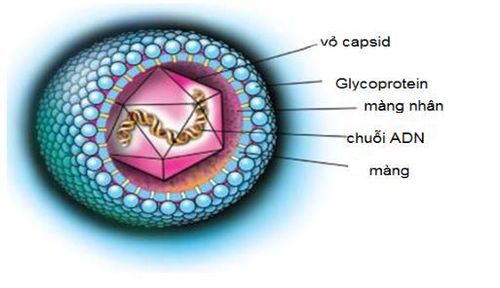This is an automatically translated article.
The article was written by MSc Ma Van Tham - Internal Medicine Doctor, Department of Pediatrics - Neonatology - Vinmec Phu Quoc International General Hospital.
Cytomegalovirus was first noticed in 1881 by Ribbert H. He discovered enlarged cells in the renal tissue of a patient with congenital syphilis and in the parotid gland for unknown reasons until Only when he read the report of Jesionek and Kiolemenoglou could he get an explanation.
1. History of finding cytomegalovirus
* In 1904, Ribbert first identified histopathological evidence of CMV, present in tissues from a congenitally infected neonate. Ribbert mistakenly assumed that the large cells he observed at autopsy were from protozoa (incorrect name Entamoeba mortinatalium).
* In 1921 Goodpasture correctly identified viruses that cause disease. The term “Cytomegalia” was introduced by Goodpasture to emphasize the natural enlargement and swelling of infected cells.
2. Structure and biological characteristics of CMV
Cytomegalovirus (CMV) is a known genus of viruses that belong to the family Herpesviridae or Herpesviruses. is a double-stranded DNA virus. Cytomegalovirus (from the Greek words cyto-, meaning "cell" and "-megalo- meaning "large") The virus name is often abbreviated as CMV. The species infecting humans is often written as human CMV (HCMV) or human herpesvirus-5 (HHV-5) and is the most studied virus.

Cytomegoloviaruses. In the Herpesviridae group, CMV belongs to the subfamily Betaherpesvirinae. According to the international classification of diseases ICD 10 is B25.
CMV shares many common features with other Herpes viruses such as having a genome and virion structure and being able to cause latent and persistent infections.
CMV has the largest genome structure among Herpes viruses. CMV is a virus with a double-stranded DNA molecule with 162 capsomeres which is essentially a hexagonal protein surrounded by a lipid membrane. CMV has the largest genome in the Herpes virus family, approximately 230-240 kilobase pairs.
Like other herpes viruses, CMV has a symmetric 20-sided polyhedral structure, replicates in the nucleus, and can cause twinning and lysis or latent infection.
CMV can be distinguished from other herpes viruses by a number of biological properties such as the type of host and cell type it causes. Replication can be classified into immediate early, delayed early and late gene expression presentation depending on the time of synthesis after infection occurs.
DNA is copied by multiple spin cycles. Viral replication involves the production of a large number of inclusions in the nucleus and a smaller amount in the cytoplasm. Viruses seem to replicate in many types of living body cells; In tissue culture, they prefer to grow in fibroblasts.
Although there is little evidence that CMV is carcinogenic in vivo, the virus can transform fibroblasts in rare cases and transgenes have been identified. .
3. Some epidemiological characteristics
3.1. The prevalence of disease in the world:
Epidemiology of the disease is still very complex, the age of Cytomegalovirus infection is highly dependent on geographical location, socioeconomic status, cultural factors and child rearing practices. .
In developing countries, most children contract cytomegalovirus early in life, with adult CMV blood infection rates approaching 100% by early adulthood.
In contrast, in developed countries, the prevalence is approximately 50% among young people of above-average socioeconomic status. This observation has important implications for the epidemiology of congenital cytomegalovirus infection because Cytomegalovirus seronegative women of childbearing age are the major risk factor for symptomatic congenital infection in neonates. first occurred during pregnancy.
Cytomegalovirus infection can occur throughout life, mainly through contact with infected secretions. Cytomegalovirus infection in infancy is common. Approximately 1% (range 0.5-2.5%) of neonates are congenitally infected with cytomegalovirus. Most infections occur in infants born to mothers with pre-existing immunity and are clinically asymptomatic at birth, however, long-term sequelae, including deafness, can occur.
The route of congenital infection is thought to be through the placenta. Cytomegalovirus can also be transmitted at birth, by vaginal secretions in the reproductive tract and through breast milk.

More than 50% of infants fed breast milk containing the virus are infected with Cytomegalovirus. In particular, a recent study reported 5 cases of severe illness and death in very low birth weight infants infected with cytomegalovirus through breast milk. Infants without cytomegalovirus infection at birth or at birth are at high risk of infection in daycare. According to some studies, the rate of Cytomegalovirus infection in kindergarten children, especially under 2 years old, is approximately 80%.
This virus can be easily transmitted to children through saliva, urine, and fomites, these children, in turn, can transmit the disease to their parents. Transmission in child care centers plays an important role in the epidemiology of cytomegalovirus infection in many young parents.
Adolescence, sexual activity is perhaps the most important route of Cytomegalovirus infection, although it has been observed that the virus is present in saliva, vaginal secretions, and semen as the main route of transmission. feebleness. Saliva is sufficient to transmit cytomegalovirus, and has resulted in negative cases of heterophile mononucleosis. Kissing appears to be one way in which Cytomegalovirus is transmitted from a toddler to a seronegative parent.
Recent Centers for Disease Control and Prevention (CDC) research has highlighted the need for public awareness of these risks and educational interventions for young women of childbearing age. to lay.
Other important routes of infection include blood transfusion and organ transplantation. Prior to testing of blood products, blood-borne cytomegalovirus was an important cause of morbidity and mortality in premature infants, however, routine use in neonatal intensive care units of the product Cytomegalovirus-free blood virtually eliminated this problem. Cytomegalovirus posttransfusion remains a risk in trauma where seronegative cytomegalovirus, in surgical patients, often presents as hepatitis.
International
Risk of congenital cytomegalovirus infection is not clearly defined in the developed world. Because studies indicate that, in developing countries, the prevalence of cytomegalovirus infection in the blood reaches 100% during very early childhood, questions about pathogenicity in these populations have received little attention. idea.
3.2. Mortality/incidence Cytomegalovirus is a significant cause of neonatal morbidity. As the most common causes, Toxoplasmosis rubella, Cytomegalovirus and Herpes simplex infection (TORCH) in the developed world, Cytomegalovirus causes diffuse neuropathy, including neurologic deafness in infants. Cytomegalovirus also accounts for significant mortality in immunocompromised patients.
3.3. Race The influence of race and genetics on the clinical manifestations of Cytomegalovirus infection is poorly understood. In several studies in the United States, a higher incidence of congenital cytomegalovirus appeared in infants born to black women. More work is needed to understand the basis for the differences in the epidemiology of cytomegalovirus infection among US community groups.

3.4. Age The annual rate of seroconversion leading to cytomegalovirus infection is approximately 1%. However, two age groups have a high rate of infection: toddlers sent to daycare and adolescents. Accordingly, those representing two potential groups need to be vaccinated.
3.5. Mode of transmission Oral and respiratory routes are the most prominent routes of CMV infection. CMV is also transmitted from person to person through saliva, urine, semen, secretions, and vaginal secretions. Blood transfusions, organ transplants of CMV infected People Sex with CMV infected people is also a transmission route of special concern. Vinmec International General Hospital is one of the hospitals that not only ensures professional quality with a team of leading medical professionals, a system of modern equipment and technology. The hospital provides comprehensive and professional medical examination, consultation and treatment services, with a civilized, polite, safe and sterile medical examination and treatment space. Customers when choosing to perform tests here can be completely assured of the accuracy of test results.
Please dial HOTLINE for more information or register for an appointment HERE. Download MyVinmec app to make appointments faster and to manage your bookings easily.














